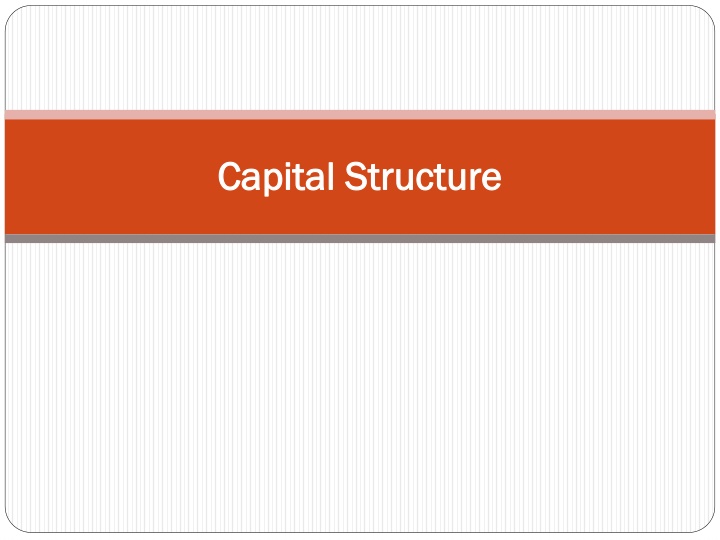
Understanding Capital Structure in Business
Explore the significance of capital structure in business, encompassing debt and equity as crucial sources of funding. Learn about different types of capital, including equity and debt, and the optimal capital structure for maximizing company value while minimizing costs.
Download Presentation

Please find below an Image/Link to download the presentation.
The content on the website is provided AS IS for your information and personal use only. It may not be sold, licensed, or shared on other websites without obtaining consent from the author. If you encounter any issues during the download, it is possible that the publisher has removed the file from their server.
You are allowed to download the files provided on this website for personal or commercial use, subject to the condition that they are used lawfully. All files are the property of their respective owners.
The content on the website is provided AS IS for your information and personal use only. It may not be sold, licensed, or shared on other websites without obtaining consent from the author.
E N D
Presentation Transcript
Capital Structure Capital Structure
The most crucial component of starting a business is capital.It acts as the foundation of the company. Debt and Equity are the two primary types of capital sources for a business. Capital structure is defined as the combination of equity and debt that is put into use by a company in order to finance the overall operations of the company and for its growth.
Types of Capital Types of Capital Structure Structure The meaning of Capital structure can be described as the arrangement of capital by using different sources of long term funds which consists of two broad types, equity and debt. The different types of funds that are raised by a firm include preference shares, equity shares, retained earnings, long-term loans etc.These funds are raised for running the business.
Equity Capital Equity Capital Equity capital is the money owned by the shareholders or owners.It consists of two different types a) Retained earning: Retained earnings are part of the profit that has been kept separately by the organization and which will help in strengthening the business. b) Contributed Capital: Contributed capital is the amount of money which the company owners have invested at the time of opening the company or received from shareholders as a price for ownership of the company.
Debt Capital Debt Capital Debt capital is referred to as the borrowed money that is utilized in business.There are different forms of debt capital. Long Term Bonds: These types of bonds are considered the safest of the debts as they have an extended repayment period, and only interest needs to be repaid while the principal needs to be paid at maturity. Short Term Commercial Paper: This is a type of short term debt instrument that is used by companies to raise capital for a short period of time
Optimal Capital Structure Optimal Capital Structure Optimal capital structure is referred to as the perfect mix of debt and equity financing that helps in maximizing the value of a company in the market while at the same time minimizes its cost of capital. Capital structure varies across industries. For a company involved in mining or petroleum and oil extraction, a high debt ratio is not suitable, but some industries like insurance or banking have a high amount of debt as part of their capital structure.
General Assumptions in Capital Structure Theories There are only two sources of funds, i.e., debts and equity (no preference share capital). The total assets of a firm and its capital employed are fixed. All earnings are distributed to equity shareholders. The firm earns operating profits and it is expected to grow. The business risk assumed to be constant and is not affected by the financing mix decision. (no change in fixed cost). There are no corporate or personal taxes. (no taxation) The investors have the same subjective profitability distribution of expected earnings.
